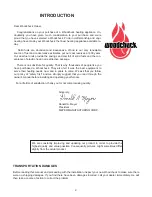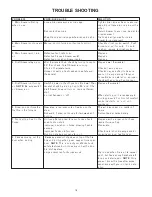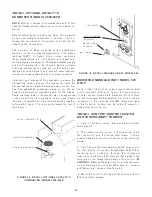
12
HELPFUL HINTS
Burning coal will provide a lesson in patience. Take the
time necessary to experiment and understand the oper-
ation of your Woodchuck wood/coal furnace.
Too much draft air will cause clinkering of coal and will
waste heat up the chimney. Shut draft down to as low a
point as you can and still heat your home.
1. NEVER stand in front of loading door when opening
it. Stand to the side.
2. NEVER completely cover the live fire with fresh coal.
Always leave a generous area of burning coal at the top
of the fire and at the rear.
3. Always keep the ash pit clean.
If the fire goes out or does not hold overnight look for:
1. Poor draft.
2. Incorrect damper settings.
3. Improper firing methods for coal being used.
4. More combustion air needed.
5. Coal not sized to furnace. We recommend 1" to 3" di-
ameter pieces of coal.
6. Ashes, if allowed to accumulate in the ash pit, will not
allow the required air for combustion. Keep ash pit
clean.
ASH REMOVAL
Ash should always be put into an air-tight, metal con-
tainer.
CAUTION
·
KEEP ASH PAN OUT OF UNIT DURING OPERA-
TION. ASH PAN CAN GET VERY HOT.
·
ASH PAN MUST BE PLACED ON A
NONCOMBUSTIBLE SURFACE.
·
NEVER USE ANYTHING BUT AN AIR TIGHT
METAL CONTAINER TO DUMP YOUR ASHES IN.
EVERY YEAR MANY FIRES ARE CAUSED BY
EMPTYING ASHES INTO CARDBOARD BOXES
OR PAPER BAGS.
·
PROVEN FACT- SMALL RED EMBERS BURIED
IN ASH CANS STAY RED HOT FOR DAYS.
ASHES ARE A GOOD THERMAL INSULATOR
AND KEEP ENOUGH OXYGEN AWAY SO THE
EMBERS DO NOT BURN OUT.
Coal firing produces much more ash than wood. These
ashes must be removed often (possibly daily) in order
to avoid piling up too closely to the grates. Removal of
the coal ash will prevent warpage and damage to
grates, and allow passage of primary air to the coal
bed.
Unlike wood ash, coal ash cannot be used as fertilizer.
All coal contains small amounts of dangerous elements.
It is therefore essential that your coal ash be disposed
of in municipally designated areas.













































